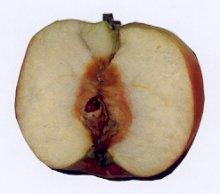The fruit adopts a dormant state resulting in only slight losses in weight, nutrients and vitamins due to the reduction in respiration. It should not be assumed that the lower the temperature at which fruit is stored, the longer it will keep. Each type of fruit has a specific "dormancy temperature", which has to be complied with exactly.
These temperatures are often a long way above freezing point, e.g. 4°C in the case of apples (their freezing point is -1.4 to -2.8°C), 13-14°C in the case of bananas, 8-10°C in the case of grapefruit (see www.tis-gdv.de/Cargo information).
If the temperature falls below the dormancy temperature, the fruit may lose its ability to ripen, i.e. green fruits, e.g. tomatoes or bananas, can no longer be caused to ripen to eating ripeness even in ripening rooms kept at 15-20°C, since the metabolic processes can no longer be set in motion. They thus lose all their utility value and remain hard and green, taste turnipy and have no aroma.
| Other typical manifestations of chilling damage are, for example, storage scald in apples, plums and citrus fruit, brown heart in apples (see Fig. 84), internal breakdown (soggy breakdown) especially in pomaceous fruit, wooliness in peaches. Fruit and vegetables with a high water content freeze at temperatures < 0°C. The greater the content of substances such as mineral salts, carbohydrates etc. dissolved in the cytosol, the lower the freezing point. Thus, for example, the freezing point of oranges is -1 to -1.2°C, while that of lemons is -1.1 to 1.5°C and that of pears is -1.5 to -3.2°C. |
 |
|
| Figure 84: Brown heart in apple; Photo: U. Schieder |
The ice crystals which arise on freezing cause mechanical damage to the cell walls and protoplasm. Cell death due to freezing results from coagulation of the protoplasm caused by dehydration and the associated increase in cytosol acidity.